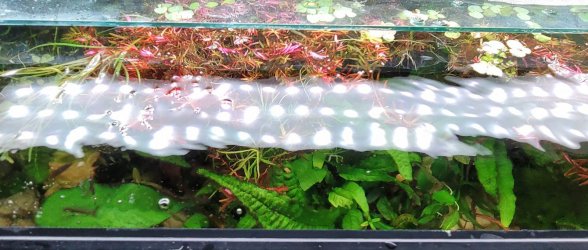The usual problem with red-leaf aquatic plants is the light. These plants require brighter light (higher intensity) than green-leaf plants. This is because the colour of the leaves is due to reflected light that we perceive as a colour. Red light along with blue (but red being the more important of the two) is necessary for photosynthesis to occur. If the plant is reflecting red light, it takes more red light to provide sufficient for photosynthesis and the colour. Red leaf plants thus tend to grow well in brighter light, but with higher light intensity also comes more nutrients, and this is where the CO2 enters the picture. Natural CO2 will usually be sufficient for green-leaf plants (always exceptions) but may not be for red.
Adding CO2 will not benefit red leaf plants unless the light intensity is balanced (and much higher). Fish do not like this, so that is another aspect.
Iron is not the issue either, as adding iron without the light and other nutrients willnot help plants, but can kill some (I had this occur).
There are some reddish or brownish-red leaf plants that can work without the higher light intensity, such as some of the Cryptocoryne species. I found these very lovely as a contrast even with my low/moderate light. There is also the red form of the Tiger Lotus, Nymphaea lotus. If you allow the floating leaves to remain they will increase (with basically no substrate-level leaves) and do quite well since they are right under the light, and the underside of the largish leaves are a lovely shade of red-purple.
Stem plants in general require brighter light (being fast growing) so red leaf stem plants like Alternanthera reineckii may struggle in less light, or melt apart completely as it did for me. Some Ludwigia has a purplish under-leaf and sometimes this grows fairly well, though not in my moderate lighting. I try plants over the years and stay with what thrives in my conditions, s the fish come first.
 8048FBB5-FF0E-41D1-8945-D9BC552BF1AE.jpeg85.7 KB · Views: 42
8048FBB5-FF0E-41D1-8945-D9BC552BF1AE.jpeg85.7 KB · Views: 42 49A01484-3221-4466-842C-09631E774AA7.png169.9 KB · Views: 38
49A01484-3221-4466-842C-09631E774AA7.png169.9 KB · Views: 38 716837CF-C40C-437B-9465-826489C63A76.png142.1 KB · Views: 36
716837CF-C40C-437B-9465-826489C63A76.png142.1 KB · Views: 36 A475D70E-9DD3-4F87-8AC9-BB471E135195.png163.6 KB · Views: 39
A475D70E-9DD3-4F87-8AC9-BB471E135195.png163.6 KB · Views: 39 34E2E12C-15B9-4846-9A1C-476DF9390704.jpeg82.4 KB · Views: 36
34E2E12C-15B9-4846-9A1C-476DF9390704.jpeg82.4 KB · Views: 36 202CA66D-5F9D-4924-B619-E983C455C0DA.jpeg55.8 KB · Views: 41
202CA66D-5F9D-4924-B619-E983C455C0DA.jpeg55.8 KB · Views: 41



